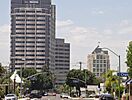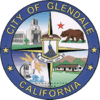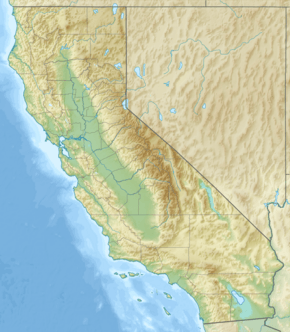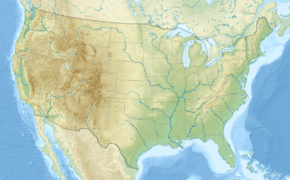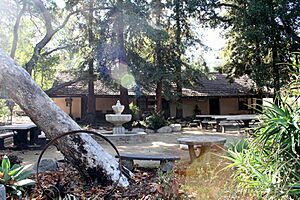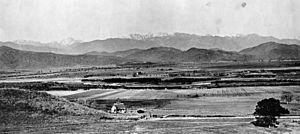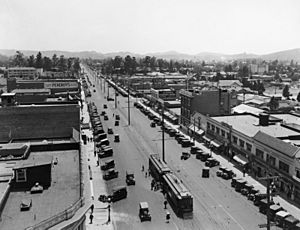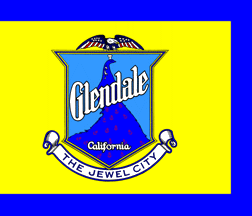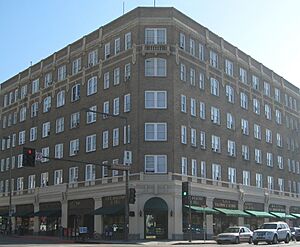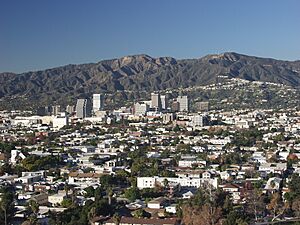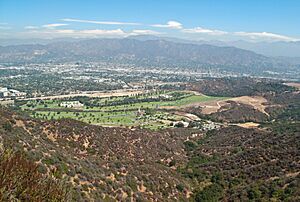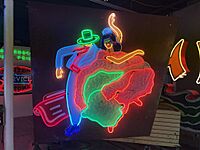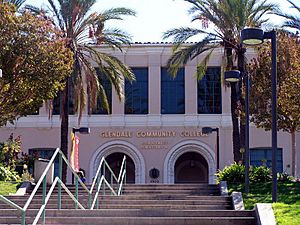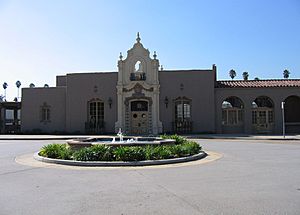Glendale, California facts for kids
Quick facts for kids
Glendale, California
|
|||
|---|---|---|---|
|
Aerial view of Glendale with the Verdugo Mountains in the background
Highrises in Downtown Glendale
Holy Family Catholic Church
St. Mark's Episcopal Church
|
|||
|
|||
| Nickname(s):
Jewel City
|
|||
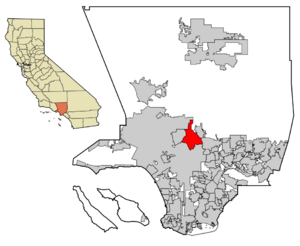
Location within Los Angeles County
|
|||
| Country | |||
| State | |||
| County | Los Angeles County | ||
| Incorporated | February 15, 1906 | ||
| Government | |||
| • Type | Council-Manager | ||
| Area | |||
| • Total | 30.60 sq mi (79.25 km2) | ||
| • Land | 30.47 sq mi (78.92 km2) | ||
| • Water | 0.13 sq mi (0.33 km2) 0.43% | ||
| Elevation | 522 ft (159 m) | ||
| Population
(2020)
|
|||
| • Total | 196,543 | ||
| • Rank | 4th in Los Angeles County 24th in California 138th in the United States |
||
| • Density | 6,450.4/sq mi (2,519.7/km2) | ||
| Demonyms | Glendalian | ||
| Time zone | UTC−8 (Pacific) | ||
| • Summer (DST) | UTC−7 (PDT) | ||
| ZIP Codes |
91201–91210, 91214, 91221, 91222, 91224–91226
|
||
| Area code | 747 and 818 | ||
| FIPS code | 06-30000 | ||
| GNIS feature IDs | 1660679, 2410597 | ||
Glendale is a city in Los Angeles County, California, United States. It is mostly in the Verdugo Mountains area. A smaller part of the city is in the San Fernando Valley.
As of 2023, about 187,050 people live in Glendale. This makes it the 4th largest city in Los Angeles County. It is also the 24th largest city in California. Glendale is located about 10 miles (16 km) north of downtown Los Angeles.
Glendale is a suburb in the Los Angeles metropolitan area. It is surrounded by many other cities and neighborhoods. These include Burbank, Pasadena, and parts of Los Angeles like Eagle Rock. Major freeways like the Golden State and Ventura freeways run through the city.
Contents
History of Glendale
Early Spanish and Mexican Rule
In 1798, a Spanish soldier named José María Verdugo received land called Rancho San Rafael. He had been using this land for farming and raising animals since 1784. This was a special permission from the Spanish government.
In 1821, New Spain became independent from Spain. Rancho San Rafael then became part of the new Mexican Republic.
Glendale's Beginnings: 1847 to Today
Mexican rule ended after the Mexican-American War in 1847. The United States took control of California. The Treaty of Guadalupe Hidalgo in 1848 said that existing land grants would be respected.
In 1860, Teodoro Verdugo, José María Verdugo's grandson, built the Catalina Verdugo Adobe. This is the oldest building in Glendale. Important leaders met here in 1847 to decide to surrender to American forces.
Verdugo's family later sold parts of the ranch. These parts now include areas like Atwater Village and Eagle Rock.
In 1884, people living in the area decided to form a town and named it "Glendale." A nearby town called Tropico was formed in 1887.
Leslie Coombs Brand was an important person in Glendale's early days. In 1904, he built a unique mansion called El Miradero. He also helped bring the Pacific Electric Railway, known as the "Red Cars," to the area. This train service connected Glendale to Downtown Los Angeles and Burbank.
Brand loved to fly airplanes. In 1919, he built a private airstrip. This airstrip was connected to the Grand Central Airport, which was built later. Today, Brand's estate is a city park called Brand Park. His mansion is now the Brand Library.
The Forest Lawn Memorial-Park opened in 1906. In 1920, Henry R. Harrower opened his clinic in Glendale. For many years, it was the city's largest business.
In 1922, the old Atwater Tract Office was taken down. Construction began on the Glendale Transportation Center.
Glendale adopted its first city flag on September 18, 1924. It was designed by Hugh A. Maron. The flag was later changed to the current one in 2001.
Grand Central Airport became a very important place. It was where Charles Lindbergh started the first commercial flight across the country from west to east.
Community Changes Over Time
For a long time, Glendale had rules that made it difficult for non-white people to live or stay in the city after dark. This changed over time as more diverse groups moved to Glendale.
In the 1970s, many Armenian families began moving to Glendale. This was due to events like the Lebanese Civil War and the Iranian Revolution. Later, more Armenians arrived from the former Soviet Union.
By the late 1980s, Armenian students became the largest ethnic group in Glendale's public schools. By 1999, about 25% of the city's population spoke Armenian. Many Armenian businesses also opened.
According to the 2000 Census, Glendale was home to 65,343 Armenian Americans. This made up 34.1% of the total population. By 2005, Armenians made up about 40% of the population. They also held a majority of seats on the Glendale city council.
The Armenian National Committee of America-Western Region opened its headquarters in Glendale in 1994. Many other Armenian organizations also have a presence in the city.
The Mexican American community grew in Glendale by the 1960s. Many moved there for better education and a safer environment.
As of 2012, Filipino Americans became the third largest minority group in Glendale. In 2022, the Filipino American Friendship Monument was unveiled in Central Park.
Geography and Climate
Where is Glendale?
Glendale is in the southeastern part of the San Fernando Valley. It covers about 30.5 square miles (79 square kilometers) of land. Only a small part of it is water. Glendale is the fourth largest city in Los Angeles County.
It is bordered by several communities. To the north are La Cañada Flintridge and La Crescenta. To the south are Atwater Village and Glassell Park. To the east are Pasadena and Eagle Rock. To the west are Griffith Park and Burbank.
Earthquakes and Geology
Like much of Southern California, Glendale is located near several earthquake faults. These include the Sierra Madre and Hollywood faults. The Verdugo and Raymond faults also run through the city.
The San Andreas Fault, a very large fault, is about 29 miles (47 km) from Glendale. The last major earthquake on the southern San Andreas was in 1857.
In the 1971 San Fernando earthquake, Glendale had 31 buildings severely damaged. Many chimneys also fell. The 1994 Northridge earthquake also caused damage to parking structures in Glendale.
Glendale's Weather
Glendale has a Mediterranean climate. This means it has hot summers and mild winters. It usually rains in the winter months.
The highest temperature ever recorded in Glendale was 115°F (46°C) in September 2020. The lowest was 17°F (-8°C) in February 1990. August is usually the warmest month, and January is the coolest.
On average, Glendale gets about 17 inches (436 mm) of rain each year. Most of this rain falls between November and April. Snow is very rare in Glendale, happening only every five to ten years in the hills.
Sometimes, strong winds called Santa Ana winds blow through the area. These can reach up to 70 mph (110 km/h).
People and Community
| Historical population | |||
|---|---|---|---|
| Census | Pop. | %± | |
| 1910 | 2,746 | — | |
| 1920 | 13,536 | 392.9% | |
| 1930 | 62,736 | 363.5% | |
| 1940 | 82,582 | 31.6% | |
| 1950 | 95,702 | 15.9% | |
| 1960 | 119,442 | 24.8% | |
| 1970 | 132,664 | 11.1% | |
| 1980 | 139,060 | 4.8% | |
| 1990 | 180,038 | 29.5% | |
| 2000 | 194,973 | 8.3% | |
| 2010 | 191,719 | −1.7% | |
| 2020 | 196,543 | 2.5% | |
| 2023 (est.) | 187,050 | −2.4% | |
| U.S. Decennial Census 2020 and 2023 | |||
As of 2023, Glendale has about 187,050 residents. In 2020, about 22.9% of the population was under 18 years old. About 18.4% were 65 or older.
In 2021, Glendale's population included:
- 54,000 children under 18 years old.
- 10,100 women who live alone.
- 7,000 men who live alone.
Different Cultures in Glendale
| Race / Ethnicity (NH = Non-Hispanic) | Pop 2000 | Pop 2010 | Pop 2020 | % 2000 | % 2010 | % 2020 |
|---|---|---|---|---|---|---|
| White alone (NH) | 105,597 | 117,929 | 122,519 | 54.16% | 61.51% | 62.34% |
| Black or African American alone (NH) | 2,230 | 2,325 | 3,365 | 1.14% | 1.21% | 1.71% |
| Native American or Alaska Native alone (NH) | 293 | 192 | 203 | 0.15% | 0.10% | 0.10% |
| Asian alone (NH) | 31,227 | 31,073 | 29,461 | 16.02% | 16.21% | 14.99% |
| Pacific Islander alone (NH) | 143 | 105 | 120 | 0.07% | 0.05% | 0.06% |
| Other race alone (NH) | 370 | 366 | 709 | 0.19% | 0.19% | 0.36% |
| Mixed race or Multiracial (NH) | 16,661 | 6,315 | 6,591 | 8.55% | 3.29% | 3.35% |
| Hispanic or Latino (any race) | 38,452 | 33,414 | 33,575 | 19.72% | 17.43% | 17.08% |
| Total | 194,973 | 191,719 | 196,543 | 100.00% | 100.00% | 100.00% |
Glendale is known for its diverse population. Many different ethnic groups live here.
Armenian Community
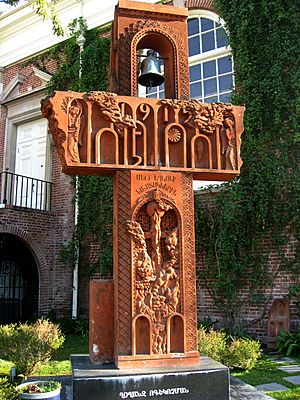
Glendale has one of the largest communities of Armenian people in the United States. Armenian families have lived in the city since the 1920s. However, many more arrived starting in the 1970s.
Armenian Americans are an important part of the city. They have many businesses, schools, and cultural groups. By 2005, Armenians made up 40% of Glendale's population.
Other Ethnic Groups
The Mexican American community grew in Glendale by the 1960s. Many moved to Glendale for good schools and a safe environment.
Several cities in Korea have tried to build business and cultural ties with Glendale.
As of 2012, Filipino Americans were the third largest minority group in Glendale. They made up seven percent of the city's population. In 2022, a monument celebrating Filipino American friendship was put up in Central Park.
Places of Worship
Glendale has many different places of worship.
- St. Mark's Episcopal Church was built in 1948.
- Holy Family Catholic Church was built in 1922.
- St. Mary's Armenian Apostolic Church has served Glendale since 1975.
- The Cathedral of Saint Gregory the Illuminator was built in 2001.
- The Islamic Center of Glendale, a Sunni mosque, opened in 2012.
- Temple Sinai, a Reform synagogue, has served Glendale since 1949.
Economy and Industries
Glendale is home to many large companies. These include the U.S. headquarters of International House of Pancakes. Avery Dennison Corp., a company that makes labels, moved its headquarters to Glendale in 2013.
As of 2024, some of the top employers in Glendale are:
- Glendale Unified School District (4,000 employees)
- Adventist Health Glendale (2,600 employees)
- City of Glendale (1,904 employees)
- Countrywide Home Loans (1,815 employees)
- Glenair Inc. (1,768 employees)
- Glendale Community College (1,500 employees)
- Walt Disney Imagineering (1,011 employees)
- DreamWorks Animation (847 employees)
Aviation History
Grand Central Airport was a very important airport. It opened in 1923 and was Glendale's largest employer for many years. It played a big role in the history of aviation in the United States.
The main terminal building still stands. It was the first official airport terminal for the Los Angeles area. It was also where Charles Lindbergh started the first commercial flight across the country. During World War II, the airport building was camouflaged to protect it. The airport closed in 1959. Now, it is the Grand Central Business Centre, an industrial park.
Film and Television in Glendale
Glendale is a major center for the American film industry, especially for animation.
The Alex Theatre was a favorite place for Walt Disney in the 1930s. He would watch his cartoons there to see how audiences reacted. After his death in 1966, Disney was buried at Forest Lawn Memorial Park.
When The Walt Disney Company needed more space, it expanded to Glendale. The headquarters for Imagineering moved there. From 1985 to 1995, Walt Disney Animation Studios was also in Glendale.
Today, Disneytoon Studios is still in Glendale. The Disney Animation archive, called the Animation Research Library, is also there. Disney's Grand Central Creative Campus is home to Disney Consumer Products, Disney Interactive, Marvel Animation, and The Muppets Studio.
DreamWorks Animation is also located in Glendale. It is in the city's Grand Central Business Centre.
In 2024, East End Studios finished building a new film production complex in Glendale. It has two sound stages. A second, even larger facility is being built.
Arts and Culture
Food in Glendale
Glendale's food scene is influenced by its many different cultures. You can find a wide range of international foods. This includes Filipino cuisine and Armenian cuisine.
Zhengyalov Hatz is an Armenian restaurant in Glendale. It is the only Armenian restaurant in the United States mentioned in the Michelin Guide.
Famous Places to See
Important landmarks in Glendale include the Alex Theatre, the Glendale Main Post Office, and the Glendale Transportation Center.
Libraries and Museums
The Glendale Public Library has 8 public libraries in the city.
In 2016, the Museum of Neon Art (MONA) moved to downtown Glendale. This museum shows historical neon signs. It also has exhibits about the local community.
In 2024, the Martial Arts History Museum moved to Glendale. This museum shows the history of martial arts from different countries. It includes displays on Chinese kung fu, Filipino kali, and Japanese judo.
Local galleries in Glendale include ace/121 Gallery and Tufenkian Fine Arts.
Performing Arts
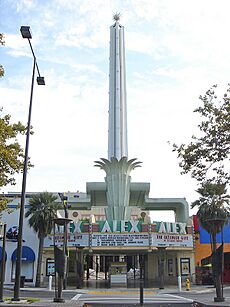
The Alex Theatre opened in 1925. It used to show vaudeville acts and silent films. Today, it is a performing arts center. It hosts live shows and movie screenings.
Local theatre companies include Antaeus Theatre Company.
The City of Glendale also hosts several concert series. These include the Brand Summer Music Series and the Jewel City Concert Series.
Art in Public Spaces
Glendale has many public art projects. "Beyond the Box" is a program that turns utility boxes into more than 150 murals. "Creative Crosswalks" is a program that creates crosswalk murals.
In 2016, an old 1936 Streamline Moderne filling station was turned into a public art gallery.
Parks and Recreation
Glendale has almost 50 public parks. These range from Deukmejian Wilderness Park in the north to Cerritos Park in the south.
Education
The Glendale Unified School District runs the public schools in Glendale. It has 20 elementary schools, 4 middle schools, and 4 high schools. There are also schools for homeschoolers and students with special needs. Many private schools also operate in Glendale.
Glendale Community College has been serving Glendale since 1927.
Media
Newspapers
The Glendale News-Press has been Glendale's main English newspaper since 1928. Another English newspaper, the Crescenta Valley Weekly, covers the northern part of Glendale. Nor Hayastan is the city's Armenian language newspaper. Balita Media publishes two English newspapers for the Filipino community.
Radio Stations
Several radio stations broadcast from Glendale:
- 870 KRLA – (Conservative talk radio)
- 95.9 KFSH – (Contemporary Christian music)
- 101.9 KSCA – (Regional Mexican music)
Television Stations
KABC-TV, an ABC television station, has been in Glendale since 2000.
Since 2013, USArmenia TV has been based in Glendale. This station shows Armenian language sitcoms, reality television, and news.
Transportation
Bus Services
Several bus services run in Glendale, including LADOT, Metro Local, and Glendale Beeline. The Glendale Transportation Center also connects to Greyhound buses.
There are plans for a new bus rapid transit line. It would connect downtown Burbank to Glendale. This line is expected to open in 2027.
Train Services
Metrolink trains stop at the Glendale Transportation Center. These include the Antelope Valley Line and Ventura County Line. Amtrak's Pacific Surfliner also stops there.
Studies are being done to add more frequent train service. They are also looking into a light rail line through Glendale's commercial area.
Streetcar Project
The City of Glendale is studying a plan for a streetcar system. It would have 16 stops and run for about 2.88 miles (4.63 km). It would connect to the Glendale Transportation Center.
Airports
The closest airport to Glendale is the Hollywood Burbank Airport. It is owned by the cities of Burbank, Glendale, and Pasadena.
Freeways and Major Roads
Glendale is served by four freeways:
- The Glendale Freeway (State Route 2)
- The Ventura Freeway (State Route 134)
- The Foothill Freeway (Interstate 210)
- The Golden State Freeway (Interstate 5)
Many major roads also run through the city. These include Brand Boulevard, Broadway, and Central Avenue.
Notable People from Glendale
- Tatev Abrahamyan, chess player
- Allisyn Ashley Arm, actress
- Chet Baker, jazz musician
- Christian Bergman, baseball pitcher
- Aloe Blacc, musician
- David Brin, author
- Julia Butters, child actress
- John Cho, actor
- Claudia Christian, actress
- Ray Combs, former Family Feud host
- Doug Davidson, soap opera actor
- Bette Davis, actress
- John Debney, composer
- Emilio Delgado, actor (Luis on Sesame Street)
- Nicole Eggert, actress
- Erika Eleniak, model and actress
- Robert Englund, actor (Nightmare on Elm Street)
- Edward Furlong, actor
- Beverly Garland, actress
- Daryl Gates, former LAPD police chief
- Scott Gorham, musician
- Woody Guthrie, musician
- Joe Hahn, musician
- Arin Hanson, animator and YouTuber
- Tim Heidecker, comedian
- Pamela Hensley, actress
- Taraji P. Henson, actress
- Babe Herman, MLB right fielder
- Hardcore Holly, professional wrestler
- Chris Holmes, guitarist
- Kathy Ireland, model and actress
- Jay-R, actor and TV host
- Nicole Jung, KPop artist
- Margaret Kerry, actress
- Don Knotts, Emmy-winning actor
- Nathan Kress, actor
- Shia LaBeouf, actor
- Mario Lopez, TV personality
- Benji Madden, musician
- Joel Madden, musician
- Daron Malakian, guitarist
- Vanes Martirosyan, boxer
- Tim Matheson, actor
- Doug McClure, actor
- Eva Mendes, actress
- Terry Moore, actress
- Dennis Muren, special effects artist
- Clarence Nash, original voice of Donald Duck
- Taylor Negron, actor and comedian
- Ken Osmond, actor (Leave It to Beaver)
- Kelly Packard, actress
- Paul Petersen, actor (The Donna Reed Show)
- Sam Phillips, musician
- Jamie Pineda, singer
- Scott Radinsky, MLB pitcher
- Ronnie Radke, vocalist
- James Rallison, YouTuber (TheOdd1sOut)
- Michael Richards, actor (Seinfeld)
- Nicole Richie, fashion designer
- Debra Jo Rupp, actress
- Bob Siebenberg, drummer
- Rick Springfield, musician
- Casey Stengel, MLB Hall of Fame manager
- System of a Down, alternative metal band
- Diana Taurasi, WNBA player
- Vic Tayback, actor (Alice)
- Paul Walker, actor
- John Wayne, iconic film actor
Sister Cities
Glendale has sister city relationships with several cities around the world:
 Martuni, Artsakh
Martuni, Artsakh Gyumri, Armenia
Gyumri, Armenia Kapan, Armenia
Kapan, Armenia Santiago, Dominican Republic
Santiago, Dominican Republic Higashiōsaka, Japan
Higashiōsaka, Japan Rosarito Beach, Mexico
Rosarito Beach, Mexico Tlaquepaque, Mexico
Tlaquepaque, Mexico Boeun, South Korea
Boeun, South Korea Gimpo, South Korea
Gimpo, South Korea Goseong, South Korea
Goseong, South Korea Santa Rosa, Laguna, Philippines
Santa Rosa, Laguna, Philippines
See also
 In Spanish: Glendale (California) para niños
In Spanish: Glendale (California) para niños




